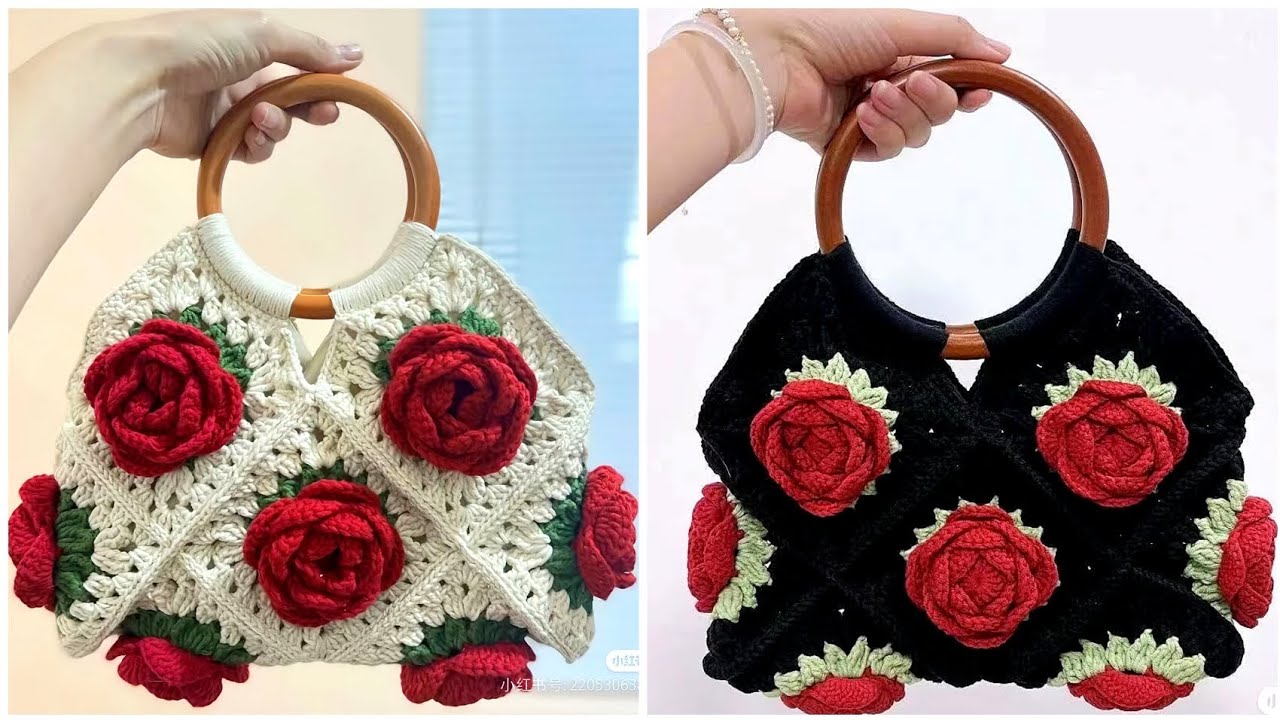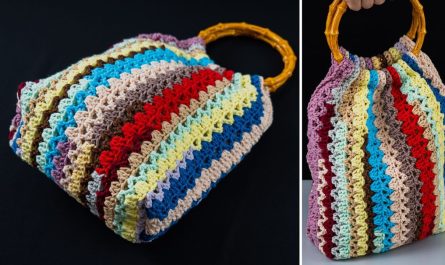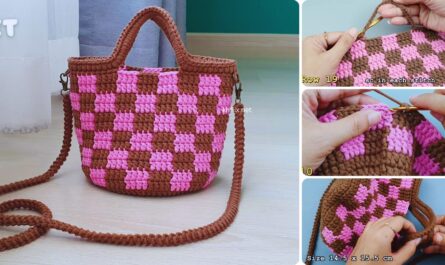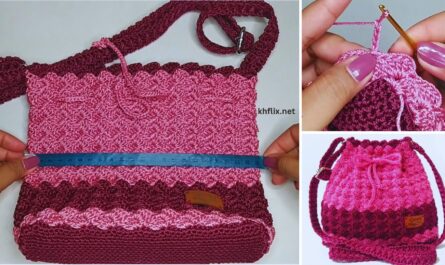Let’s create a stunning crochet handbag adorned with a beautiful rose flower! This project combines the practicality of a handmade bag with the timeless elegance of a crocheted rose, making it a truly special accessory. You’ll learn to make a sturdy bag body and then craft a dimensional rose to embellish it.
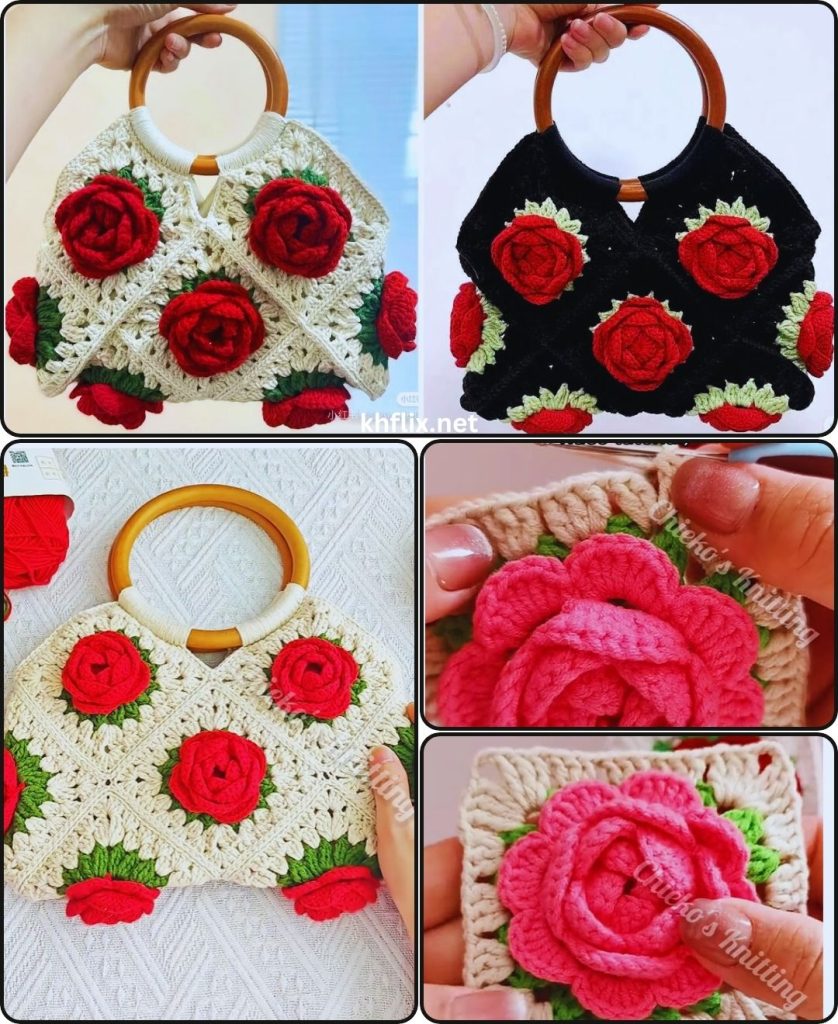
How to Make a Beautiful Crochet Handbag with a Rose Flower
This comprehensive tutorial will guide you through crocheting a chic and functional handbag, then show you how to create and attach an elegant crocheted rose for a personalized, artistic touch. We’ll focus on a dense stitch for the bag’s structure and clear instructions for the rose, ensuring a beautiful finished product.
Skill Level: Intermediate
This project is ideal if you’re comfortable with:
- Chain (ch): The basic foundation.
- Slip Stitch (sl st): For joining rounds and neatening.
- Single Crochet (sc): A dense stitch, great for sturdy bag fabric.
- Half Double Crochet (hdc): A good intermediate stitch for height.
- Double Crochet (dc): A common stitch for taller elements.
- Magic Ring (MR): An adjustable ring to start circular projects neatly (alternative provided).
- Working in rounds/rows: Crocheting in a circular/oval manner and back-and-forth.
- Working into specific stitches or chain spaces.
- Creating a strong, even tension.
- Weaving in ends securely.
Finished Bag & Rose Dimensions (Approximate):
This pattern creates a medium-sized handbag, typically around 10-12 inches (25-30 cm) wide and 8-10 inches (20-25 cm) tall (excluding handles). The crocheted rose will be about 2.5-3.5 inches (6.5-9 cm) in diameter, making it a prominent focal point.
Materials You’ll Need:
- Yarn:
- Main Bag Color: Approximately 400-600 yards (365-550 meters) of Worsted Weight (Medium #4) Cotton or Cotton Blend Yarn. Cotton is highly recommended for bags due to its durability, minimal stretch, and excellent stitch definition. Choose a classic or complementary color (e.g., black, cream, grey, navy, or a deep jewel tone).
- Rose Color: Approximately 15-25 yards (14-23 meters) of Worsted Weight (Medium #4) Yarn in your desired rose color (e.g., classic red, soft pink, ivory, or deep burgundy).
- Green Yarn (Optional for leaves): A few yards of Worsted Weight (Medium #4) Yarn in a shade of green for small leaves.
- Crochet Hook: Size H/5.0mm. This size creates a dense fabric suitable for a sturdy bag and works well for the rose too.
- Yarn Needle (Tapestry Needle): Essential for seamlessly weaving in all your loose yarn tails and for securely sewing the rose (and optional leaves) onto the bag.
- Scissors: For cutting your yarn.
- Stitch Marker (Optional but Highly Recommended): Very helpful for marking the beginning of your rounds.
- Bag Handles (Optional): A pair of ready-made bag handles (bamboo, leather, or plastic rings) or you can crochet your own straps (instructions provided for crocheted handles).
- Fabric Lining (Optional but Recommended): About 0.5-1 yard (0.45-0.9 meters) of coordinating fabric, needle, and thread/sewing machine for a more professional finish and added durability.
- Magnetic Snap Closure (Optional): For a secure closing mechanism.
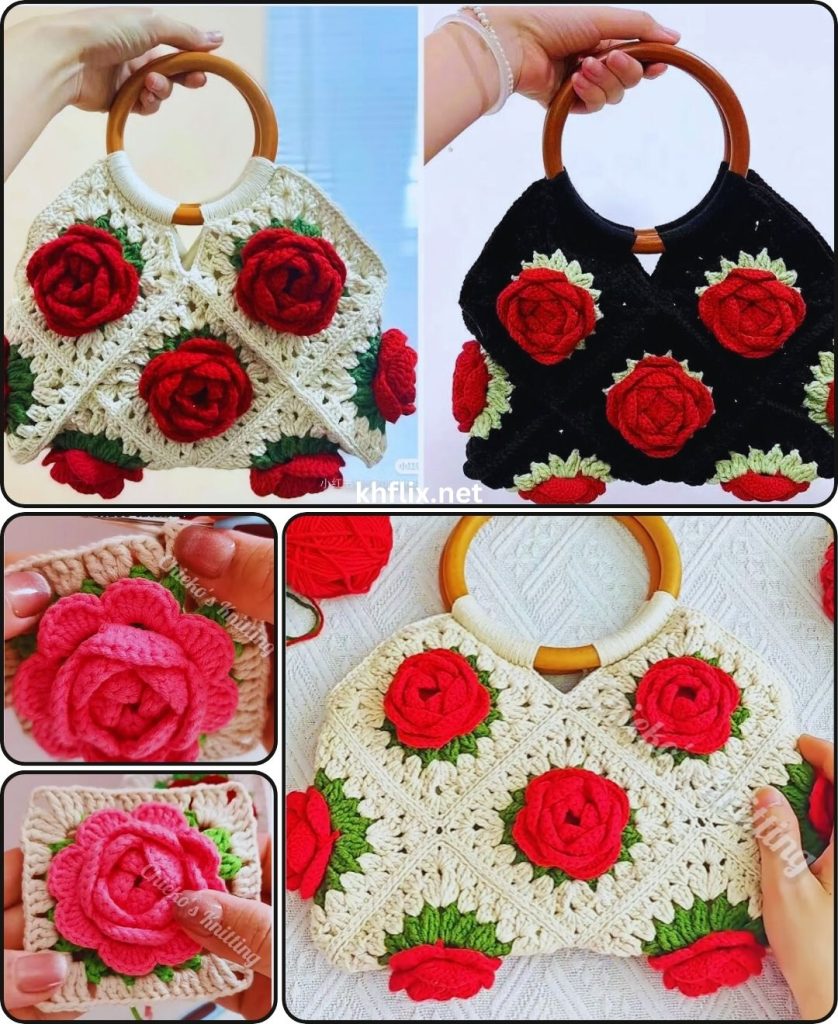
Understanding the Bag & Rose Construction:
We’ll approach this project in two main phases:
- Crocheting the Handbag: This forms the sturdy base for your floral art. It will be built seamlessly from an oval base.
- Crocheting and Attaching the Rose (and optional leaves): You’ll create the rose separately and then carefully sew it onto the finished bag.
Let’s Crochet Your Handbag with a Rose Flower!
Part 1: Crocheting the Handbag
We’ll use a simple yet strong stitch pattern (single crochet) to ensure your bag is durable and holds its shape well.
- Crocheting the Sturdy Oval Base (Main Bag Color):
- Make a slip knot and chain 31. (Adjust for desired bag width. An odd number here will give you an even stitch count after the first round.)
- Round 1: Work 2 sc into the 2nd ch from your hook. Work 1 sc into each of the next 28 chains across. Work 3 sc into the very last chain. Working down the opposite side of the foundation chain: Work 1 sc into each of the next 28 chains across. Work 1 sc into the very first chain (the one where you initially put 2 sc). Sl st into the first sc to join. [Total: 62 sc]
- Round 2: Ch 1 (does not count as a stitch). Work 2 sc into the first stitch. Work 1 sc into the next 29 stitches. Work 2 sc into each of the next 3 stitches. Work 1 sc into the next 29 stitches. Work 2 sc into each of the last 2 stitches. Sl st into the first sc to join. [Total: 68 sc]
- Round 3: Ch 1. Work 2 sc into the first stitch. Work 1 sc into the next 30 stitches. Work 2 sc into each of the next 3 stitches. Work 1 sc into the next 30 stitches. Work 2 sc into each of the last 2 stitches. Sl st into the first sc to join. [Total: 74 sc]
- Base Check: Your base should be a flat oval. Adjust increases if it curls or ruffles. Do not fasten off.
- Building the Bag Body (Main Bag Color):
- Transition Round: Ch 1. Work 1 single crochet in the Back Loop Only (BLO) of each stitch around. Sl st into the first sc to join. [Total: 74 sc] (This creates a defined edge, helping the bag stand upright.)
- Body Rounds: Ch 1. Work 1 sc into each stitch around (now working through both loops). Sl st into the first sc to join. Repeat this round for approximately 20-25 more rounds, or until your bag reaches the desired height (e.g., 8-10 inches / 20-25 cm).
- Maintain consistent tension for an even fabric. Do not fasten off.
- Adding the Top Border (Main Bag Color):
- Border Rounds: Ch 1. Work 1 sc into each stitch around. Sl st into the first sc to join. Repeat this round for 3-4 more times. This creates a very dense and firm top border.
- Optional Firm Edge (Crab Stitch): For an exceptionally firm and decorative edge, add a final round of Crab Stitch (Reverse Single Crochet). Ch 1. Work 1 sc into the stitch to your right (working backward) in each stitch around. Sl st into the first crab stitch to join.
- Fasten off, leaving a 6-inch (15 cm) tail for weaving in.
- Crafting and Attaching the Handles (Main Bag Color or Purchased):
- A. If using purchased handles: Position your handles evenly on the top rim of the bag. Use your yarn needle and a matching yarn tail (or strong thread) to firmly stitch the handles to the bag’s top border. Go through multiple times for security.
- B. If crocheting handles (Make 2):
- Ch 60-70 (adjust for desired strap length).
- Row 1: Work 1 sc into the 2nd ch from hook. Work 1 sc into each remaining ch across. [Total: 59-69 sc]
- Ch 1, turn.
- Row 2: Work 1 sc into each sc across the row. [Total: 59-69 sc]
- Repeat Row 2 for 2-3 more rows until your handle reaches the desired width (e.g., 4-5 rows total for a sturdy handle).
- Fasten off, leaving a very long tail (at least 15-20 inches / 38-50 cm) at each end of the strap for sewing.
- Make a second identical strap.
- Attaching Crocheted Handles: Lay your bag flat. Position the handles on the inside of the bag’s top border. Typically, each handle is centered over the side curve, approximately 2.5-3.5 inches (6-9 cm) in from the side edges. Thread a long tail from a handle onto your yarn needle. Stitch firmly back and forth through the handle end and the bag’s top border multiple times to ensure a very strong attachment. Repeat for all four handle ends. Weave in any remaining handle tails very securely.
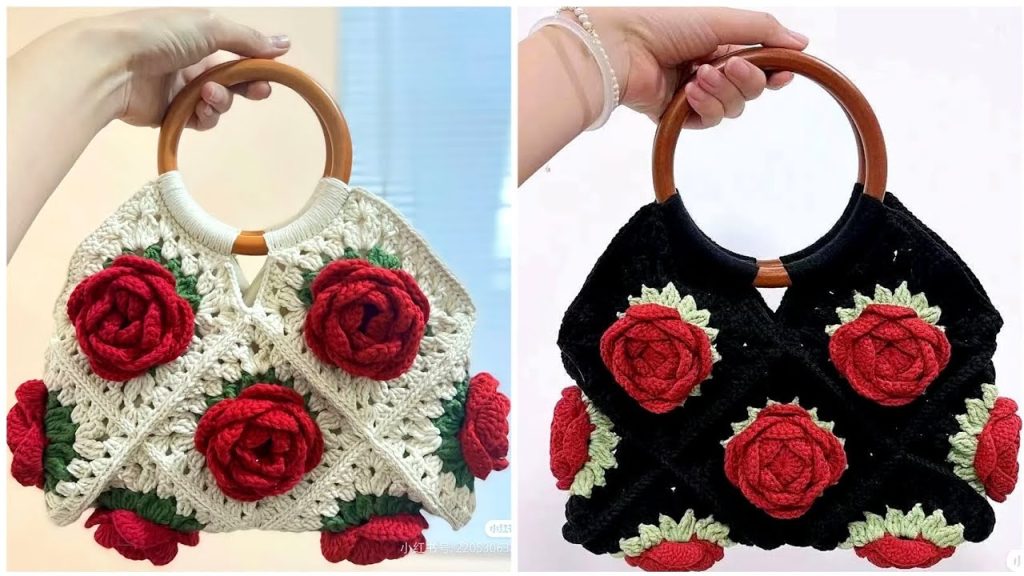
Part 2: Crocheting and Attaching the Rose (and Optional Leaves)
Now for the beautiful focal point! We’ll use the “spiral rose” method.
- Crocheting the Rose Strip (Rose Color):
- Make a slip knot with your rose color yarn and chain 30-40 (the longer the chain, the fuller the rose). For a medium rose, ch 35.
- Row 1 (Foundation): Work 1 sc into the 2nd ch from your hook. Work 1 sc into each remaining ch across. [Total: 34 sc for ch 35 example]. Ch 1, turn.
- Row 2 (Petal Formation – Inner Layer): Work 1 hdc into the first stitch. Work 2 hdc into the next stitch. Repeat this pattern: * 1 hdc into the next stitch, 2 hdc into the next stitch * across the row. This creates the wavy inner petals. Ch 2, turn.
- Row 3 (Petal Formation – Outer Layer): Work 1 dc into the first stitch. Work 2 dc into the next stitch. Repeat this pattern: * 1 dc into the next stitch, 2 dc into the next stitch * across the row. This creates the taller outer petals. Ch 1, turn.
- Row 4 (Base Edge): Work 1 sc into the first stitch. Work 1 sc into each stitch across the row. This creates a clean, straight edge that will be the base of your rose.
- Fasten off, leaving a very long tail (at least 15-20 inches / 38-50 cm) for assembling the rose.
- Assembling the Rose:
- Lay your crocheted strip flat. One side (from Row 4) will be relatively straight, and the other side (from Rows 2 and 3) will be wavy.
- Take the starting end of the strip (the short tail end) and begin to tightly roll it inward towards the first few stitches. This forms the tight center bud of your rose.
- As you continue to roll, loosen your tension slightly. You want the outer layers to be a bit looser and more open, like natural rose petals. Keep rolling the strip around the central bud, allowing the wavy edges to naturally create the petal layers. The
scedge (Row 4) should form the bottom base of your rose as you roll. - Once you’ve rolled the entire strip into a rose shape, hold it firmly.
- Thread the long tail you left onto your yarn needle.
- Stitch firmly through all the layers of the rose at its base to secure them. Insert your needle from one side of the base, pass it through all the layers, and bring it out the other side. Repeat multiple times in different directions across the base to ensure it’s very firmly secured and won’t come apart. The stitches should be on the underside of the rose, out of sight. Weave in any remaining tail securely into the base of the rose. Weave in the short starting tail too.
- Crocheting Optional Leaves (Green Yarn – Make 1-2):
- Make a slip knot with green yarn and chain 8.
- Work 1 sl st into the 2nd ch from hook.
- Work 1 sc into the next ch.
- Work 1 hdc into the next 2 ch.
- Work 1 sc into the next ch.
- Work 1 sl st into the last ch.
- Ch 2 (this creates a little point for the leaf).
- Working down the opposite side of the foundation chain:
- Work 1 sl st into the same last ch.
- Work 1 sc into the next ch.
- Work 1 hdc into the next 2 ch.
- Work 1 sc into the next ch.
- Work 1 sl st into the next ch.
- Fasten off, leaving a tail for sewing. Weave in ends.
- Attaching the Rose (and Leaves) to the Handbag:
- Decide on the perfect placement for your rose on the front of your handbag. Typically, it looks best slightly off-center or in one of the lower corners.
- Use your yarn needle and a yarn tail from the rose’s base to securely stitch the rose onto the bag. Go through the very base of the rose and into the stitches of the bag. Make sure your stitches are invisible from the front of the rose. Stitch all around the base to ensure it’s firmly attached.
- If you made leaves, position them at the base of the rose and stitch them securely to the bag as well. Weave in all remaining tails very neatly.
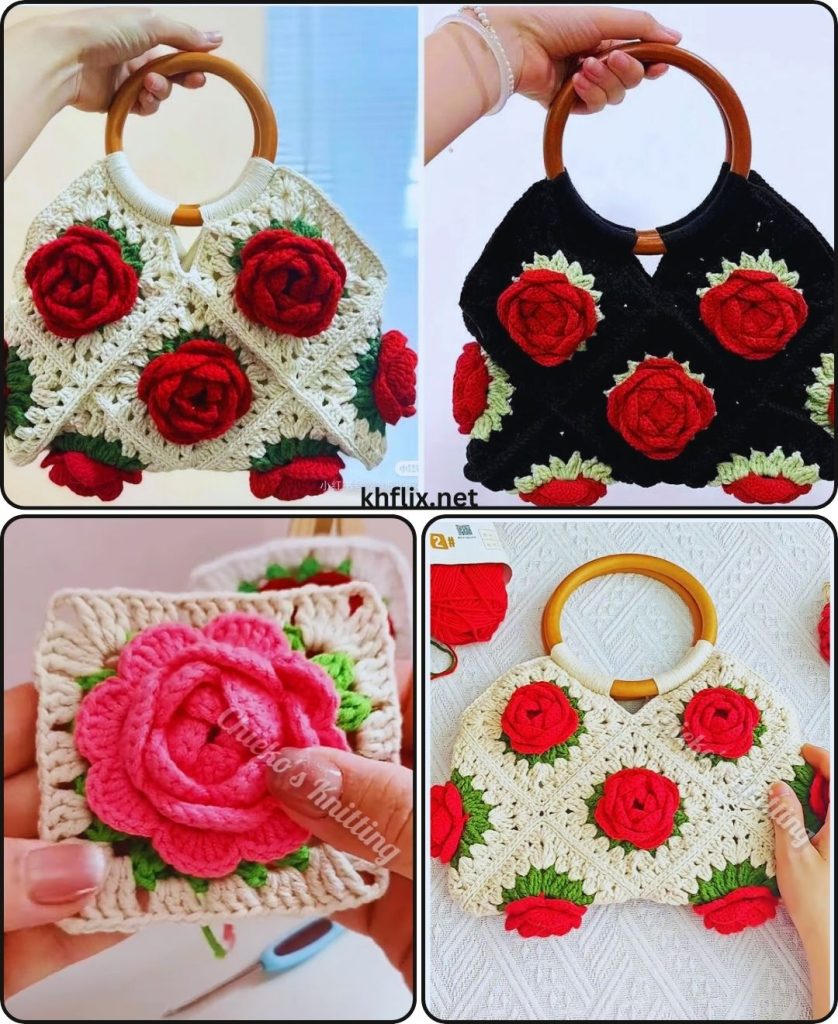
Part 4: Final Finishing Touches
- Weave in ALL Remaining Ends:
- This is paramount for a professional-looking and durable handbag. You’ll have tails from your bag construction, handle attachments, and the rose/leaves. Use your yarn needle to meticulously weave in every single loose yarn tail.
- Technique: Weave into stitches of the same color. Go in one direction for 1.5-2 inches (4-5 cm), then change direction and weave back through some of the same stitches to “lock” the tail. Trim excess close to the fabric.
- Blocking (Optional but Highly Recommended):
- Blocking can significantly improve the shape, drape, and overall finish of your crocheted bag and help the rose sit beautifully.
- Method (Wet Blocking – Ideal for Cotton/Acrylic):
- Gently stuff your bag with clean towels or crumpled paper to fill it to its desired shape. Avoid overstuffing.
- Using a spray bottle, lightly mist the entire bag and rose evenly with water until damp but not soaking wet.
- Carefully shape the bag, ensuring the base is flat, sides are even. Gently arrange and shape the petals of your rose as desired.
- Allow the bag to air dry completely and thoroughly in a well-ventilated area before removing the stuffing. This can take 24-48 hours.
- Add a Fabric Lining (Optional for Professional Finish):
- A fabric lining provides a smooth interior, hides all your yarn tails, prevents small items from slipping through stitches, and adds significant durability and structure.
- Measure the inside dimensions of your finished bag. Cut fabric pieces (typically two main body pieces and one bottom piece) adding a seam allowance.
- Sew the fabric pieces together to create an inner lining bag.
- Insert the fabric lining into your crocheted bag.
- Fold over the top raw edge of the fabric lining and hand-stitch it neatly to the inside top border of your crocheted bag using a needle and matching thread.
- Add a Magnetic Snap Closure (Optional):
- If you want a closure, purchase a magnetic snap. Position the two halves on the inside of the bag’s top border, making sure they align. Use a needle and strong thread to sew them securely to the inside of the crocheted fabric or the fabric lining if you added one.
Congratulations! You’ve successfully created a truly unique and beautiful crochet handbag adorned with an elegant rose flower! This handmade creation is not just a practical accessory; it’s a piece of wearable art, showcasing your skill and creativity. Enjoy carrying your exquisite new bag wherever you go!

